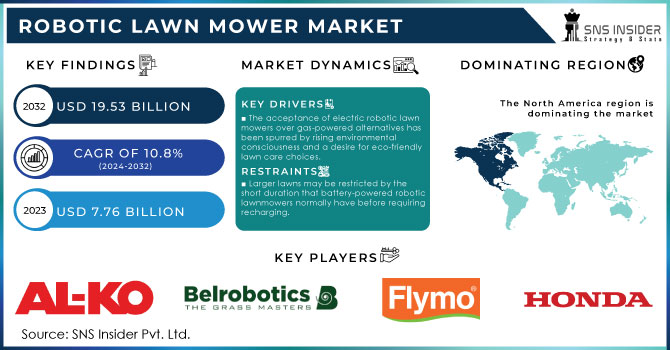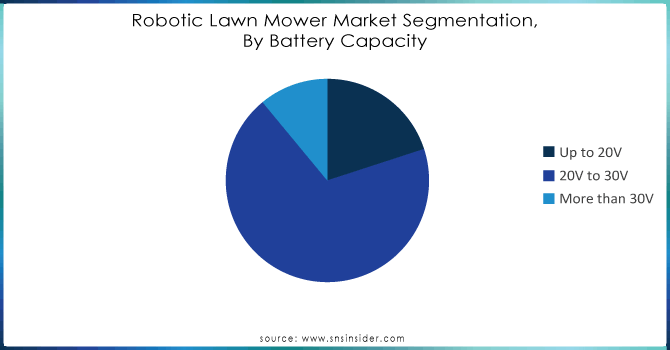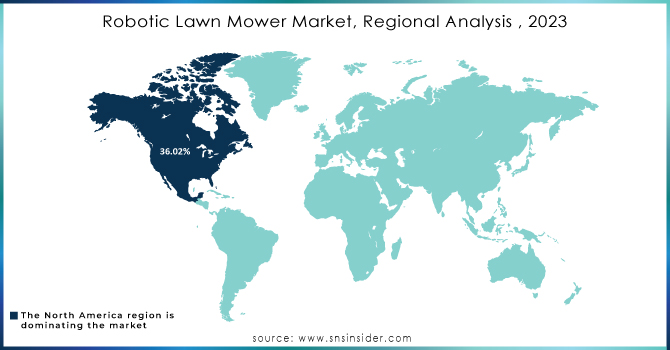Robotic Lawn Mower Market Report Scope & Overview:

To get more information on Robotic Lawn Mower Market - Request Free Sample Report
The Robotic Lawn Mower Market size was estimated at USD 7.76 billion in 2023 and is expected to reach USD 19.53 billion by 2032 at a CAGR of 10.8% during the forecast period of 2024-2032.
The industry was anticipated to expand at a significant rate due to the increasing preference of lawn care and gardening in high-income residents. This is due to increasing end-user income levels and rising demand for robotic lawn mowers. It was found that a mower enhances appearance and user experiences. In addition, this invention has a specific. The emergence of high-end products and technology is expected to be the primary driver of expansion for this market. The wooden mowers utilize this wire to determine the part of the plot that needs to be chopped and sometimes to locate a recharging station. Most of these robotic devices can maintain about 320,000 sq.ft of grass. Robotic mowers that are under 60 decibels may sometimes mow in situations where other ordinary lawn mower are not allowed to operate. The robotic mower sleeps in the day and works in any lawn, whether making a manicure in the middle of the night. The robot grass cutter can work with any slope of your garden or plot, returning to the charging point whenever it stops. The range of noise among the least quiet robot lawn mower to the loudest is from 58 to 74 dB.
Increased expenditure on backyard beautification, landscaping, garden parties, and backyard cookouts, among others, and consumer need to save on time spent on lawn maintenance activities are the key factors expected to drive the global demand for gardening tools. The growth of the market is also attributable to the increasing construction and tourism industries and the rising disposable income of people across the global scales. Furthermore, the anticipated financial hitches in the global demand for robotic lawn mowers are expected to generate positive shifts in the global demand. A number of consumers in the US, Germany, and the UK, among other regions in the global scale, are currently dedicating considerable amounts of time and financial resources into bettering their gardens, yards, and lawns. The consumer approach is expected to increase the global demand for smart lawn care products that save time, money, and energy. Consequently, the high spending by consumers in the beautification of their backyard area is expected to drive the growth of the market.
DRIVERS
The acceptance of electric robotic lawn mowers over gas-powered alternatives has been spurred by rising environmental consciousness and a desire for eco-friendly lawn care choices.
The increasing popularity of electric robotic lawn mowers over polluting gas-powered models is mainly due to a number of factors. Due to the growing attention of buyers to environmental issues, solutions contributing to their resolution appear to be of the greatest interest. Such an approach allows people to notice that traditional gas-powered lawn mowers are not quite eco-friendly. Firstly, they had a non-renewable gas that produced gases hazardous to the environment. Gas also contributes to the impoverishment of the atmosphere and entices into it noise that exceeds environmental standards. Mowers are also relatively safe for buyers, especially for children and animals. The electric lawn mower in this case is much cleaner. They only work on the battery built into them which, of course, allows these lawn mowers to maintain the environment. This type of mower is less expensive to use. Refuelling is not required, and the periodic replacement of several special parts does not create a burden on the budget. Other advantages of electric robotic mowers are that they are a reliable and durable supply of batteries. This generation of batteries, which is currently being produced, allows these lawn mowers to be used by both ordinary buyers and professional builders of the lawn. One big advantage is the ability of people to provide them with work according to the schedule selected by homeowners. Most of these devices have a built-in controller that allows the lawn to maintain the same size, and even without human intervention. The new electric mowers also create a sense of security for adults, and headphones are worth the kids and the animals. The number of new models per year is growing and is only on the rise. The electric lawn mower has also lessened in price, so it is no longer labelled as an exclusive unit, so more and more people are opting for it.
Robotic lawnmowers are finding an increasing market in areas with older populations because they appeal to people who would find it difficult to maintain a regular lawn.
Robotic lawnmowers are becoming more and more popular in regions with older populations for numerous reasons. On the one hand, with age come physical limitations, and older individuals often may find it much more difficult than they did previously to actually perform all labour-intensive work in the garden, including mowing, edging or raking. Those who need some help also need the labour-intensive work that is a part of traditional lawn maintenance done for them. This is where the robotic lawnmower comes in play. This device provides for a labour-free, hands-free solution to lawn maintenance. Additionally, the robotic lawnmower operates in full-automatic mode since the device operates by advanced sensory and navigation systems, ensuring the device actually avoids any type of obstacles, maintains its designated cutting pattern and docks itself to the charger when the battery gets empty. This device can provide a timely solution to the lawn-maintenance needs of senior citizens and older individuals who cannot actually perform the tasks themselves.
The robotic lawnmowers contribute to a great level of safety, which is important for older individuals who risk getting in a considerably hazardous situation of getting injured by traditional lawnmowers, and risking getting cut by their rotating blades. In addition to this, robotic lawnmowers turn off automatically when left, tilted or picked up and are thus overall, completely safe for use. Finally, since one of the most major issues raised by the usage of traditional lawnmowers is the noise and pollution they create, and therefore exposing the user and other individuals who spend time in the yard to the detrimental consequences that come by noise, robotic lawnmowers are a quiet, pollution-free machine suitable for this purpose.
The current trend increases that in the aging communities there is a growing use of robotic lawnmowers, which is a part of the wider process of the utilization of smart home technology. There are many smart devices that are utilized by older adults and that simplify human lives. Robotic mowers are no more an exception here as by owning and utilizing such devices, the older adults keep their lawns beautiful without the need to use additional physical efforts and move the mower around. Therefore, due to the ongoing process of the older generation’s increase, the demand for robotic lawnmowers will only grow as people will need accessible and simple-to-use devices to maintain their households.
RESTRAIN
Larger lawns may be restricted by the short duration that battery-powered robotic lawnmowers normally have before requiring recharging.
The battery-powered robotic lawnmowers face when dealing with larger lawns is that of battery life. Most mowers are designed to be used primarily on smaller lawns, running for 60 to 90 minutes between each charge. Not only is this a significant oversight for a larger lawn, where the mower would be expected to run for several hours, but the need for multiple recharging cycles appears to be fundamentally opposed to the idea of the robotic mower as a time-saving device. Moreover, having to recharge the mower every hour or so during a typically two or three hour-long mowing session will likely lead to the user losing interest and allowing the lawn to grow. It seems unlikely that a robotic mower would be the best option for the owner of the linked property, at least without doing further research into more powerful models. An alternative option worth exploring is, of course, that of a traditional gas-powered mower while non-automatic and potentially damaging to the environment, gasoline mowers can easily be used to mow very large properties, as they do not have the same constraints on battery life.
KEY MARKET SEGMENTATION
By Battery Capacity
The 20V to 30V battery segment held a market share of over 69.02% in 2023, based on battery capacity. These batteries are mostly used in robotic lawn mowers for commercial applications. Those types of devices are costlier and are used to mow lawns of 1.0 to 2.5 acres and are seen in commercial spaces such as sports/golf field and hospitality industries. The segment delivers adequate power to handle intensive load-carrying capacities, traverse a way and climb up slopes or ramps. Besides, the batteries have a longer life cycle that enables the operations to be performed smoothly without issues.

Need any customization research on Robotic Lawn Mower Market - Enquiry Now
By Application
The residential sector is the segment representing the largest market share of over 57.03% in 2023. The growth in the demand for ease and time-saving solutions has prompted homeowners to switch to automatic applications that can get the job done without any voluntary input of the people residing in this area. This application allows these individuals to spend more time running errands and doing other things.
By Sales Channel
The retail stores/offline segment had the largest share of revenue of over 58.04% in 2023. The escalating demand for time-saving and convenient solutions has compelled traditional retail stores to capitalize on the use of robotic lawn mowers, which are an ease to homeowners who have very minimal time to spend mowing their lawns. Robotic lawn mowers target a wide range of end users from the busy professionals who do not have time and want to come home to groomed lawns, to the elderly who may not have the physical strength to mow the lawns as well.
REGIONAL ANALYSES
North America dominated the market with a revenue share of over 36.02% in 2023. Busy lifestyle patterns resulted in end users’ approach towards automatizing the conventional lawn maintenance activities. The robotic lawn mowers are equipped with sensors, GPS navigation systems and artificial intelligence and for every lawn size and complexity, it navigates and maintains it efficiently. Work is performed end-to end without any input from users, which allow end users to spend their time with families and maintain their focus on more important activities. Also, use of new technologies for automating lawn care routines is another factor influencing the market growth.
Asia Pacific region is expected to register the highest CAGR over the forecast period. The rapid urbanization and increasing affluence across the region have resulted in demand for smart solutions for a more convenient life. Robotic lawn mowers fit this trend by providing automatic and simple lawn care systems. Helper robots, such as robotic lawn mowers operate in gardens and yards, managing everything from cleaning pools and leaf blowing to raking leaves. The presence of countries like China, Japan and South Korea as the forerunners in adopting automation and robotics has made the market more favorable for technologies such as robotic lawn mowers.

KEY PLAYERS
The major key players are AL-KO, Belrobotics, Deere & Company, Flymo, HONDA MOTOR CO., LTD, Husqvarna Group,Robert Bosch GmbH, Robomow Friendly House, The Toro Co, STIGA S.p.A., WIPER S.R.L., Worx and others.
RECENT DEVELOPMENT
In January 2024: The company HOOKII Neomow launched new advancements in robotic lawn mowers such as LiDAR (Light Detection and Ranging) and SLAM (Simultaneous Localization and Mapping). LiDAR technology allowed mowers to create a more accurate map of their surroundings, enabling them to navigate more efficiently and avoid obstacles more effectively. SLAM This technology allowed mowers to build a map of their surroundings as they move, eliminating the need for perimeter wires.
In May 2022: Toro for the domestic lawn care sector, Toro revealed a robotic lawn mower with cutting-edge, user-friendly technology and previously unheard-of features. The latest in smart, connected technology for homeowners and their yards is Toro's new robotic, battery-powered mower, which the company has been producing for more than a century.
| Report Attributes | Details |
| Market Size in 2023 | US$ 7.76 Bn |
| Market Size by 2032 | US$ 19.53 Bn |
| CAGR | CAGR of 10.8% From 2024 to 2032 |
| Base Year | 2023 |
| Forecast Period | 2024-2032 |
| Historical Data | 2020-2022 |
| Report Scope & Coverage | Market Size, Segments Analysis, Competitive Landscape, Regional Analysis, DROC & SWOT Analysis, Forecast Outlook |
| Key Segments | • By Battery Capacity(Up to 20V, 20V to 30V, More than 30V) • By Application (Residential, Commercial) • By Sales Channel(Retail Store/Offline, Online Websites) |
| Regional Analysis/Coverage | North America (US, Canada, Mexico), Europe (Eastern Europe [Poland, Romania, Hungary, Turkey, Rest of Eastern Europe] Western Europe] Germany, France, UK, Italy, Spain, Netherlands, Switzerland, Austria, Rest of Western Europe]), Asia Pacific (China, India, Japan, South Korea, Vietnam, Singapore, Australia, Rest of Asia Pacific), Middle East & Africa (Middle East [UAE, Egypt, Saudi Arabia, Qatar, Rest of Middle East], Africa [Nigeria, South Africa, Rest of Africa], Latin America (Brazil, Argentina, Colombia, Rest of Latin America) |
| Company Profiles | AL-KO, Belrobotics, Deere & Company, Flymo, HONDA MOTOR CO., LTD, Husqvarna Group, Robert Bosch GmbH, Robomow Friendly House, The Toro Co, STIGA S.p.A., WIPER S.R.L., Worx |
| Key Drivers | • The acceptance of electric robotic lawn mowers over gas-powered alternatives has been spurred by rising environmental consciousness and a desire for eco-friendly lawn care choices. • Robotic lawnmowers are finding an increasing market in areas with older populations because they appeal to people who would find it difficult to maintain a regular lawn. |
| Market Challenges | • Larger lawns may be restricted by the short duration that battery-powered robotic lawnmowers normally have before requiring recharging. |

